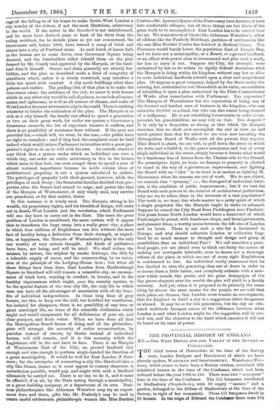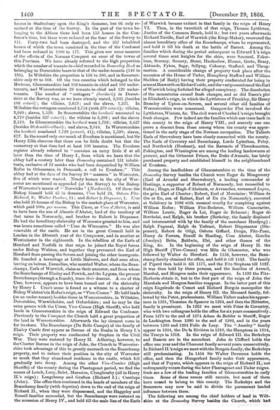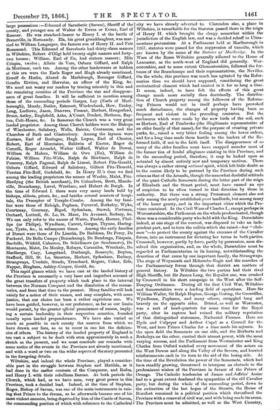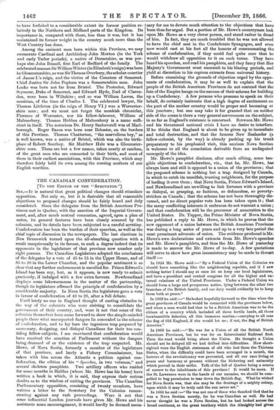THE PROVINCIAL HISTORY OF ENGLA.ND. XV.—Tnn WEST DOWNS AND THE
VALLEY OF THE SEVERN.- CONCLUSION.
THE chief towns of Dorsetshire at the time of the Survey were, besides Bridport and Dorchester, of which we have already spoken, WAREHAM and SnAprEssuaY. Wareham ( War- ham), which seems to have been a Roman station, contained 285 inhabited houses in the time of the Confessor, which had been reduced before the year 1086 to 135. There were two " moneyers" here in the time of the Confessor. The 151 burgesses attributed to Shaftesbury (Sceptesberie), with 20 empty "manses" and a garden, belonged to the Abbess of Shaftesbury at the time of the Survey, in right of her monastery. These 151 burgesses dwelt in 91 houses. In the reign of Edward the Confessor there were 101 houses in Shaftesbury upon the King's demesne, but 66 only re- mained at the time of the Survey. In the part of the town be- longing to the Abbess there had been 153 houses in the Con- fessor's time, but these were reduced at the time of the Survey to 111. Forty-two had been destroyed, and the 257 inhabited houses of which the town consisted in the time of the Confessor had been reduced in 1086 to 177. This gives one some measure of the effects of the Norman Conquest on some of the towns of this Province. We have already referred to the high proportion which the number of tenants-in-chief recorded in Domesday Book as belonging to Dorsetshire bears to that of the under-tenants (146 to 195). In Wiltshire the proportion is 156 to 286, and in Somerset- shire only 80 to 368. Of the two counties which belonged to the Hwiccas, Gloucestershire had 102 tenants-in-chief and 166 under- tenants, and Worcestershire 28 tenants-in-chief and 129 under- tenants. The number of " cottagers " (bordarii) in Dorset- shire at the Survey was, as we have already stated, 2,941 (besides 188 cotarit) ; the villeins, 2,613; and the slaves, 1,231. In Wiltshire the cottagers numbered 2,754 (with 279 cotarii); villeins, 3,049; slaves, 1,539. In Somersetshire the bordarii amounted to 4,770 (besides 327 cotarii); the 'villeins to 5,298; and the slaves 2,110. In Gloucestershire the bordarii were 1,792; villeins, 3,627 (besides 30 demidii-villanz); and slaves, 2,044. In Worcestershire the bordarii numbered 1,728 (cotarii, 41); villeins, 1,520; slaves, 677. In the record only one monk of Evesham is mentioned, but Sir Henry Ellis observes that there can be little doubt but that the monastery at that time had at least 100 inmates. The Evesham register already referred to "contains an entry little if at all later than the time of Henry I., from which we learn that the abbey half a century later than Domesday contained 131 inhabi- tants, exclusive of 12 monks who had been despatched by William Rufus to Othenensee, in Denmark, a cell to Evesham." This abbey bad at the date of the Survey 28 " masures " in Worcester, five of which were wasted. Ninety houses in the city of Wor- cester are mentioned as appended (at the Survey) to the Bishop of Worcester's manor of " Norwicke " (Northwick). Of these the Bishop himself held 45 in demesne, Um held 24, Osborn Fitz- Richard, 8; IValter l'onther, 11; and Robert is Dispenser, 1. Urso also held 25 houses of the Bishop in the market-place of Worcester, which paid 100s. per annum. This URSO, or Urso d'Abetot, is said to have been the son of Almeric d'Abetot, lord of the territory of that name in Normandy, and brother to Robert le Dispenser. He had the hereditary shrievalty of Worcester granted to him, and was hence sometimes called "Urso de Wirecestre." He was also constable of the castle. He sat in the great Council held in London in the fifteenth year of the Conqueror, and in another at Westminster in the eighteenth. In the rebellion of the Earls of Hereford and Norfolk in that reign he joined the Royal forces under Bishop Wulstan, and together they prevented the Earl of Hereford from passing the Severn and joining the other insurgents. He founded a hermitage at Little Malvern, and died soon after, leaving an heiress, Emmeline, who married Walter, whom the Beau- champs, Earls of Warwick, claim as their ancestor, and from whom the Beauchamps of Elmley and Powick, and the Lygons, the present Beauchamps (through a female), trace their descent. A son of this Urso, however, appears to have been turned out of the shrievalty by Henry L Urso's name is found as a witness to a charter of Bishop Wulstan's in Rufus's reign, as "Vice-Comes." He held lands (as an under-tenant) besides those in Worcestershire, in Wiltshire, Dorsetshire, Warwickshire, and Oxfordshire ; and he may be the same person with the Ursus, Vice-Comes (High Sheriff), who held lands in Gloucestershire in the reign of Edward the Confessor. Previously to the Conquest the Church held a great proportion of the land in Worcestershire. Afterwards the lay element came in for its share. The Beauchamps (De Bello Campo) of the family of Elmley Castle first appear as Barons of the Realm in Henry L's reign. Their property was confiscated by Stephen in the Civil War. They were restored by Henry II. Adhering, however, to the Charter Barons in the reign of John, the Church in Worcester- shire took advantage of this to greatly encroach on the Beauchamp property, and to reduce their position in the city of Worcester so much that they abandoned residence in the castle, which fell gradually into decay. Among the other Vice-Conzites (High Sheriffs) of the county during the Plantagenet period, we find the names of Lench, Lucy, Belet, Marmion, Clungleusby (all in Henry IL's reign) ; Longchamp and Grafton (Richard I.) ; Cantiupe (John). The office then continued in the hands of members of-the Beauchamp family (with deputies) down to the end of the reign of Richard II., when they were dispossessed, and the Haggeley and Russell families succeeded, but the Beauchamps were restored on the accession of Henry IV., and held till the male line of the Earls
of Warwick became extinct in that family in the reign of Henry VI. Then, in the twentieth of that reign, Thomas Lyttleton, Justice of the Common Bench, held it ; but two years afterwards Richard Neville, Earl of Warwick (the King-Maker), recovered the almost hereditary office of the Beauchamps, whom he represented, and held it till his death at the battle of Barnet. Among the families which during the period subsequent to Edward I.'s reign several times sent knights for the shire, were Senescal, Poker- ham, Sturney, Somery, Stone, Haukeslow, Blount, Grete, Bracy, Abtunde, Fyton, Sapy, Sellyng, Cokesey, Stafford, and Throg- morton. A considerable change of property took place after the- accession of the House of Tudor, Humphrey Stafford and William. Sheldon (of Besly) having their property confiscated for being in arms at Bosworth on Richard's side, and the vastpossessions of the Earl of Warwick being forfeited for alleged conspiracy. The dissolution. of the monasteries caused fresh changes, and so did Essex's plot in Elizabeth's reign, in which the Lyttletons of Frankley, Sir Henry Bromley of Upton-on-Severn, and several other old families of Worcestershire were concerned. Gunpowder Plot involved the Lyttletons, Winters, &c. The civil wars of Charles L's reign brought fresh changes. Few indeed are the families which can trace back in this county to the reign of Henry VIII., and scarcely one can. prove a descent from those among whom the county was appor- tioned in the early stage of the Norman occupation. The Talbots Earls of Shrewsbury have been closely connected with the county._ The Earls of Coventry and Beauchamp, Lords Lyttelton, Foley, and Northwick (Rushont), and the Baronets of Throckmorton, Pakington, and Winnington are among the leading landowners at present, and the Orleanist Prince, the Duke d'Aumale, has lately purchased property and established himself in the neighbourhood of Evesham.
Among the landholders of Gloucestershire at the time of the- Domesday Survey besides the Church were Roger de Mongomery (Earl of Arundel and Shrewsbury), a leading commander at Hastings, a supporter of Robert of Normandy, but reconciled, ta Rufus ; Hugo, or Hugh d'Abrincis, or Avranches, surnamed Lupus, the grim Earl of Chester ; Robert, Earl of Moretaine ; William de Ow or Eu, son of Robert, Earl of Eu (in Normandy), executed at Salisbury in 1096 with unusual cruelty for conspiring against William Rufus ; William Fitz-Boderon, William CatnerariuS, William Leuric, Roger de Loi, Roger de Belmont ; Roger de Berchelai, and Ralph, his brother (Berkeley, the family displaced and intermarried with by the family of the merchant Hardyng) ; Ralph Paganal, Ralph de Todenai, Robert Dispel:motor (Dis- penser), Robert de Oilgi, Osbern Giffard, Drogo, Fitz-Ponz,, Henry de Ferrero, Ernulf de Hasding, Urso Abetot, Gozelin (Jocelyn) Brito, Baldwin, Elsi, and other thanes of the King, &c. In the beginning of the reign of Henry II. the High Sheriff (Vice-Comes) was Milo de Gloucester, who was- followed by Walter de Hereford. In 1156, however, the Beau- champ family obtained the office, and held it till 1163. The family of Piperd then held it till 1171, and the Fitz-Stephens till 118T. It was then held by three persons, and the families of Avenel, Marshal, and Musgros make their appearance. In 1193 the Fitz- Herberts obtain it, but in the first part of the reign of John the Marshals and Musgros families reappear. In the latter part of this reign Engelrode de Cumet and Richard Burgeis monopolize the shrievalty. In the reign of Henry M. the Mousard family, fol- lowed by the Putot, predominate. William Talbot makes his appear- ance in 1231, Thurstan de Spencer in 1234, and then the Hittestre, family is prominent. In 1262 we meet with Peter de Coventry, who with two colleagues holds the office for six years consecutively- From 1270 to the end of 1274 Adam de Botiler is Sheriff, Roger de Lackington from 1280 to the end of 1282, and in the years between 1285 and 1294 Fulle de Lacy. The " Anesley " family appear in 1304, the De la Rivieres in 1310, the Hamptons in 1314, the Tracys in 1318. In the reign of Edward III. the Berkeleys and Bassets are in the ascendant. John de Clifford holds the- office one year and the Chiunent family several years consecutively. In Richard ll.'s reign we meet withthe Burgeis family, the Berkeleys still predominating. In 1454 Sir Walter Devereux holds the office, and then the Hungerford family make their appearance, and that of Poyntz, which appears in the reign of Richard II., not unfrequently recurs during the later Plantagenet and Tudor reigns. Such are a few of the leading families of Gloucestershire in early' times. Some of these names still remain, but most of them have ceased to belong to this county. The Berkeleys and the Somersets may now be said to divide the paramount landed influence between them.
The following are among the chief holders of land in Wilt- shire at the Domesday Survey besides the Church, which had large possessions :—Edmund of Saresberie (Sarum), Sheriff of the county, and younger son of Walter de Ewres or Evrax, Earl of Rosmar. He was standard-bearer to Henry I. at the battle of Breneville, in Normandy. Ela, his great granddaughter, was mar- ried to William Longespee, the famous son of Henry II. and Fair Rosamond. This Edmund of Saresberie had thirty-three manors in Wiltshire, Robert d'011gi held twenty-eight manors and forty- two houses ; William, Earl of Eu, had sixteen manors ; Milo Crispin, twelve ; Albric de Vere, Osbern Giffard, and Ralph de Mortimer, each ten. Among the other landowners or holders at this era were the Earls Roger and Hugh already mentioned, Ernulf de Heslin, Alured de Marleburgh, Berenger Giffard, Gozelin Riviere, and lierveius, an officer of the King, &c. We need not weary our readers by tracing minutely in this and the remaining counties of the Province the rise and disappear- ance of great families. It will be sufficient to mention among those of the succeeding periods Gorges, Ley (Earls of Marl- borough), Moody, Butler, Esteourt, Windenbank, How, Ernley, Long, Ludlowe, Jason, Danvers, Pinsent, Herbert, Hungerford, Bruce, Astley, Englefield, Ashe, A'Court, Ducket, Methuen, Bay- tun, Colt-Hoare, &c. In Somerset the Church was a very great landed proprietor. Among these Church holders were the Bishops of Winchester, Salisbury, Wells, Baieux, Coutances, and the Churches of Bath and Glastonbury. Among the laymen were Eustace, Earl of Boulogne, Hugh Lupus, Earl of Chester, Robert, Earl of Moretaine, Baldwin of Exeter, Roger de Corcelli, Roger Arundel, Walter Giffard, Walter de Dowai, William de Mohun, William de Owe (Eu), William de Falaise, William Fitz-Wido, Ralph de Mortimer, Ralph de Pomeroy, Ralph Pagenal, Ralph de Limesi, Robert Fitz-Gerald, Osborn Giffard, Edward of Salisbury, Gilbert Fitz-Thurold, Turstan Fitz-Rolf, Godebold, &c. In Henry ll.'s time we find among the leading proprietors the names of Wexbie, Malet, Fitz- Hardyng (the British merchant), De Columbers, Brett, Mande- ville, Beauchamp, Luvel, Wrotham, and Hubert de Burgh. In the time of Edward I. there were very many lands held by bishops, abbots, priors, &c., and besides several masters of hospi- tals, the Preceptor of Temple-Combe. Among the lay fami- lies were those of Raleigh, Popham, Perceval, Berkeley, Wyke, Courtenay, Gournay, Bigod, Sydenham, Stawel, Portman, Orchard, Luttrell, St. Lo, St. Maur, De Avenant, Rodney, &c. We can only refer to the names of Warre, Paulet, Homer, Phel- lips (or Philips), Wyndham, Carent, Gorges, Thynne, Haring- ton, Tynte, &c., in subsequent times. Among the early families of Dorset were those of De Lisoriis, De Raddona, De Percy, De Puckerel, De Bello Campo (Beauchamp), De Bendenge, Fitzpain, Bardolfe, Witfeld, Cahaines, De Schidimore (or Scudamore), De Montacute, Malet, De Manley, Robayn, Cormailes, Wroxhale, De M.arlberge, Cary, Longeland, Durburgh, Bonevyle, Boyton, Stafford, Hill, St. Lo, Stourton, Herbert, Sydenham, Rodney, Strangways, Uvedale, Strode, Trenchard, Rogers, Coker, Erie, Napper, Bingham, Ashley-Cooper, Gould, &c.
This rapid glance which we have cast at the landed history of the Province is necessarily a very lame and imperfect account of the great transfers of property which took place in the interval between the Norman Conquest and the dissolution of the monas- teries, and from that time to the present. Many families will look vainly for a notice of their names, and may complain, with some justice, that our choice has been a rather capricious one. We have been guided, however, in our preference, as far as our limits would permit, by the greater official prominence of names, imply- ing a certain leadership in their respective counties, founded usually upon landed preponderance. We have also varied as much as possible in each county the sources from which we have drawn our lists, so as to cover in one list the deficien- cies of others. The history of the landed property of England is too vast a subject to be dealt with even approximately in such a sketch as the present, and we must conclude our remarks with some notice of the events in the Province not already mentioned, and with a word or two on the wider aspects of the story presented in the foregoing details.
Wiltshire, and indeed the whole Province, played a consider- able part in the struggle between Stephen and Matilda, as it had done in the earlier contests of the Conqueror, and Rufus, and Henry L with their rebellious Barons. At both periods the Church, which had, as we have seen, very great power in this Province, took a decided lead. Indeed, at the time of Stephen, Roger, Bishop of Sarum, was one of the main instruments in rais- ing that Prince to the throne, as he afterwards became one of his most violent enemies, being deprived by him of the Castle of Sarum, the commanding position of which with reference to the Cathedral city we have already adverted to. Clarendon also, a place in Wiltshire, is remarkable for the Statutes passed there in the reign of Henry II. which brought the clergy somewhat within the jurisdiction of the English law, and was a decided rebuff to Ultra- montane pretensions. At a Parliament held at Marlborough in 1267, statutes were passed for the suppression of tumults, which are known by the name of the Statutes of Marlbridge. In the Wars of the Roses Wiltshire generally adhered to the House of Lancaster, as the south-west of England did generally. Wor- cestershire, and to some extent Gloucestershire, followed the for- tunes of the Beauchamps and their representatives, the Nevilles. On the whole, this province was much less agitated by the Refor- mation than we should have supposed, considering the great ecclesiastical element which had existed in it for so long a time. It seems, indeed, to have felt the effects of this great change much more socially than doctrinally. The distribu- tion of Church property among the followers of the Reform- ing Princes would not in itself perhaps have provoked much disturbance, the changes of property having been so frequent and violent in the preceding centuries. But the enclosures which were made by the new lords of the soil, such as Herbert, Earl of Pembroke (the illegitimate representative of an older family of that name), for the purpose of creating private parks, &c., raised a very bitter feeling among the lower orders, and for a long time made them hostile to the leaders of the Re- formed faith, if not to the faith itself. The disappearance of so many of the older families must have snapped asunder most of the former ties of feudal allegiance existing in this Province, and in the succeeding period, therefore, it may be looked upon as actuated by almost entirely new and temporary motives. There was always a rather strong national spirit, which left little doubt as to the course likely to be pursued by the Province during such crises as that of the Armada, though the somewhat doubtful attitude of the quasi-Catholic Somersets during the latter part of the reign of Elizabeth and the Stuart period, must have caused an eye of suspicion to be often turned in that direction by those in authority. But there was a strong Protestant element also not only among the newly established great landlords, but among many of the lesser gentry, and in the important cities which the Pro- vince contained. In the Civil Wars of Charles I., except perhaps in Worcestershire, 4he Parliament on the whole predominated, though there was a considerable party who held with the King. Dorsetshire indeed, at one stage of the contest, was disposed to take an inde- pendent part, and to turn the militia which she raised—her "club- men "—to protect the county against the excesses of the Cavalier forces, into an instrument for dictating her terms to both parties. Cromwell, however, partly by force, partly by persuasion, soon dis- solved this organization, and, on the whole, Dorsetshire must be regarded as Parliamentarian in its leaning, notwithstanding the desertion of that cause by one important family, the Strangways. The siege of Weymouth and Melcombe-Regis and the marches of the Parliamentary forces through that district are matters of general history. In Wiltshire the two parties had their rival High Sheriffs, but Sir James Long, the Royalist one, was crushed by Cromwell in his short campaign in the West after the Self- Denying Ordinance. During all the first Civil War, Wiltshire and Somersetshire were a leading field of operations. Here Sir William Waller, Sir Ralph Hopton, George Goring, the Grenvilles, Wyndhams, Pophams, and many others, struggled long and bravely on the opposite sides. Bristol, as well as Worcester, was a sort of head-quarters for some time for the Royal party, after its capture had ruined the military reputation of that distinguished statesman, Nathaniel Fiennes. Here sat Hyde and Culpeper and Arthur Capel as a Council for the West, and here Prince Charles for a time made his sojourn. In the open field the Somersets on one side, and the Herberta and Berkeleys on the other, exerted their utmost power, with the most varying success, and the Parliament from Westminster and King Charles from Oxford watched every movement of the actors on the West Downs and along the Valley of the Severn, and hurried reinforcements each in its turn to the aid of the losing side. At the time of the Revolution the power of the Somersets, which had been steadily growing, threatened to interpose an obstacle to the predominant wishes of the Province in favour of the Prince of Orange. The Catholic tendencies of James and Jeffries' Assize had to a great extent deadened the sympathies of the old Cavalier party, but during the whole of the succeeding period, down to the extinction of the last hopes of the Stuarts, the House of Beaufort remained in a political position which threatZned the Province with a renewal of civil war, and with being made its arena. The Province must be admitted, as well as the West Country,
to have forfeited to a considerable extent its former position re- latively to the Northern and Midland parts of the Kingdom. Its importance is, compared with these, less than it was, but it has maintained its former weight in the country much more than the West Country has done.
Among the eminent men born within this Province, we may enumerate Cardinal and Archbishop John Morton (in the York and early Tudor periods), a native of Dorsetshire, as was per- haps also John Russell, first Earl of Bedford of the family. The celebrated seaman Sir William Winter (in Elizabeth's reign) was born in Gloucestershire, as was Sir Thomas Overbury, the scholar-courtier of James I.'s reign, and the victimof the Countess of Somerset. Chief Justice Sir John Popham was a Somersetshire man. John Locke was born not far from Bristol. The Protector, Edward Seymour, Duke of Somerset, and Edward Hyde, Earl of Claren- don, were born in Wiltshire ; and so was William Lewes, the musician, of the time of Charles I. The celebrated lawyer, Sir Thomas Littleton (in the reign of Henry VI.) was a Worcester- shire man ; and we must not forget the monkish chronicler, Florence of Worcester, nor his fellow-labourer, William of Malmesbury. Thomas Hobbes of Malmesbury is a name suffi- cient in itself. The notorious Dr. Henry Sacheverell was of Marl- borough. Roger Bacon was born near Echester, on the borders of this Province. Thomas Chatterton, "the marvellous boy," as is well known, was a native of Bristol, which was also the birth- place of Robert Southey. Sir Matthew Hale was a Gloucester- shire man. These are but a few names, taken nearly at random, of the great men who are connected in their birth, and most of them in their earliest associations, with this Province, which may therefore fairly hold its own among the nursing mothers of our English worthies.

































 Previous page
Previous page